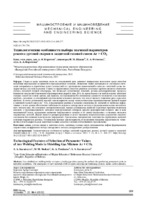| dc.contributor.author | Коротеев, А. О. | |
| dc.contributor.author | Шукан, Н. М. | |
| dc.contributor.author | Фетисова, Е. А. | |
| dc.contributor.author | Коротеева, А. А. | |
| dc.coverage.spatial | Минск | ru |
| dc.date.accessioned | 2023-08-10T07:28:27Z | |
| dc.date.available | 2023-08-10T07:28:27Z | |
| dc.date.issued | 2023 | |
| dc.identifier.citation | Технологические особенности выбора значений параметров режима дуговой сварки в защитной газовой смеси Ar CO2 = Technological Features of Selection of Parameter Values of Arc Welding Mode in Shielding Gas Mixture Ar CO2 / А. А. Коротеева [и др.] // Наука и техника. – 2023. – № 4. – С. 269-277. | ru |
| dc.identifier.uri | https://rep.bntu.by/handle/data/133565 | |
| dc.description.abstract | Сварка в среде защитных газов на сегодняшний день занимает лидирующее положение среди способов получения неразъемных соединений в промышленных условиях. Появление новых материалов со сложными системами легирования и упрочнения делает углекислый газ, традиционно применяемый в качестве защитной среды, неэффективным для использования. Одним из эффективных способов решения указанных проблем является изменение состава защитной газовой атмосферы, что позволяет существенно изменить физико-металлургические процессы плавления электродной проволоки и формирования сварного шва. В то же время переход на использование защитных газовых смесей на основе аргона, как правило, осуществляется без понимания сущности технологии и возможных проблем, связанных со спецификой проплавления основного металла, что может вызвать появление ряда серьезных проблем. В статье установлены важные закономерности между технологическими характеристиками дуговой сварки в защитной газовой смеси Ar + CO2 и параметрами режима в условиях отклонения их значений от наиболее эффективных с точки зрения обеспечения стабильности переноса электродного металла и формирования валика наплавленного металла шва. На основании экспериментальных данных установлены наиболее вероятные причины появления опасного и трудновыявляемого методами неразрушающего контроля дефекта формирования сварного шва в виде несплавлений между отдельными валиками наплавленного металла и по линии сплавления с основным металлом свариваемых деталей. Дефект является распространенным и может вызывать непредсказуемое разрушение сварного соединения без видимых пластических деформаций. Предложены эмпирические зависимости определения значений основных параметров режима. Установлены важные закономерности, позволяющие повысить эффективность технологии дуговой сварки в среде защитных газовых смесей в условиях отечественного производства. | ru |
| dc.language.iso | ru | ru |
| dc.publisher | БНТУ | ru |
| dc.title | Технологические особенности выбора значений параметров режима дуговой сварки в защитной газовой смеси Ar CO2 | ru |
| dc.title.alternative | Technological Features of Selection of Parameter Values of Arc Welding Mode in Shielding Gas Mixture Ar CO2 | ru |
| dc.type | Article | ru |
| dc.identifier.doi | 10.21122/2227-1031-2023-22-4-269-277 | |
| local.description.annotation | Gas-shielded arc welding today occupies a leading position among the methods for producing permanent joints in industrial conditions. The emergence of new materials with complex alloying and hardening systems makes carbon dioxide, traditionally used as a protective medium, inefficient for use. One of the effective ways to solve these problems is to change
the composition of the protective gas atmosphere, which allows you to significantly change the physical and metallurgical
processes of melting the electrode wire and the forming the weld. At the same time, the transition to the use of protective
gas mixtures based on argon is usually carried out without understanding the essence of the technology and possible problems
associated with the specifics of penetration of the base metal, which can cause a number of serious problems. The present
paper describes important regularities between technological characteristics of arc welding in a shielding gas mixture
Ar + CO2 and welding mode parameters under conditions of deviation of their values from the most effective ones in
order to ensure the stability of the processes of electrode metal transfer and the formation of the deposited weld metal bead.
On the basis of experimental data, the most probable causes of the appearance of a dangerous and difficult-to-detect defect in
the formation of a welded seam in the form of non-fusion between individual beads of the deposited metal and along the fusion line
with the base metal of the welded parts have been established. The defect is common and can cause unpredictable failure of the
welded joint without visible plastic deformation. Empirical dependences for determining values of the main parameters of the welding
mode are proposed as well. Important regularities have been established that make it possible to increase the efficiency of arc
welding technology in the environment of protective gas mixtures in the conditions of domestic production. | ru |

